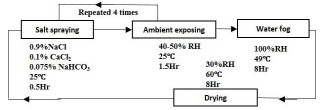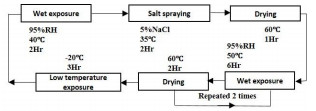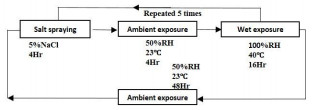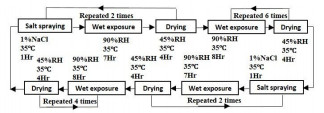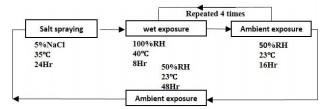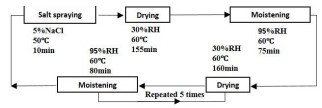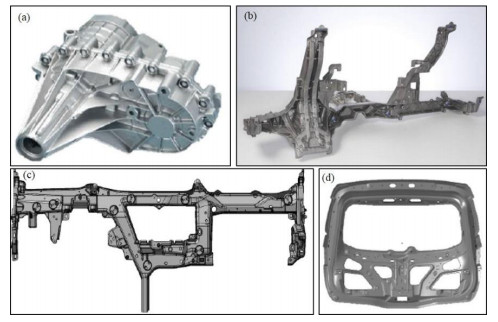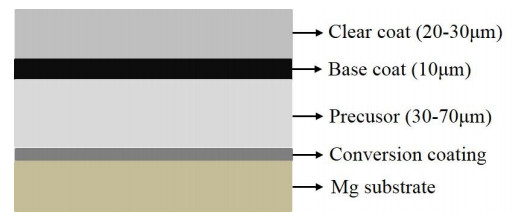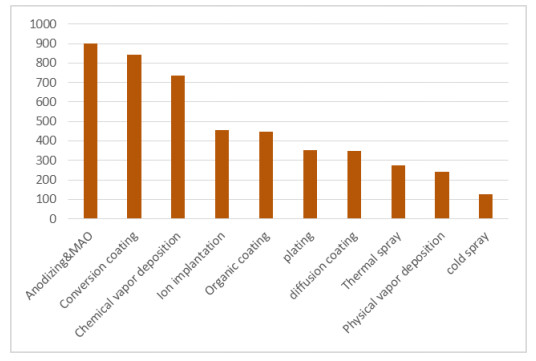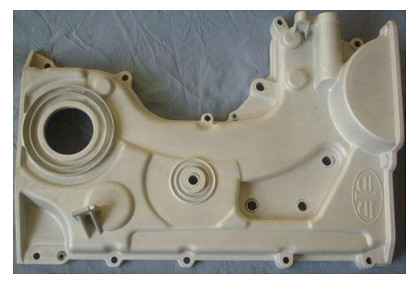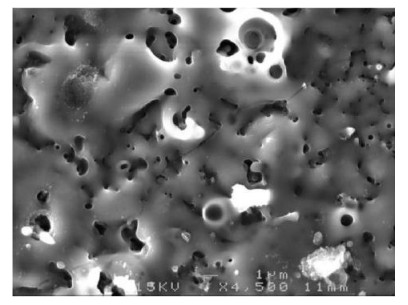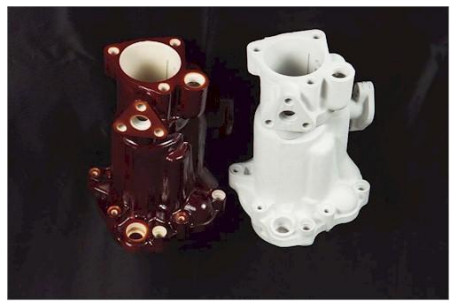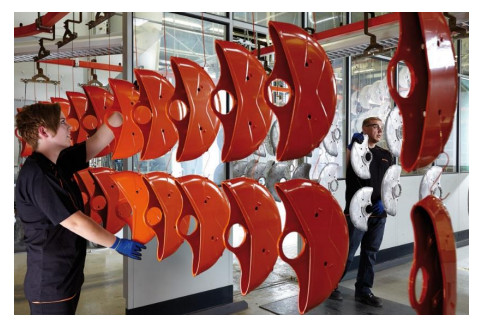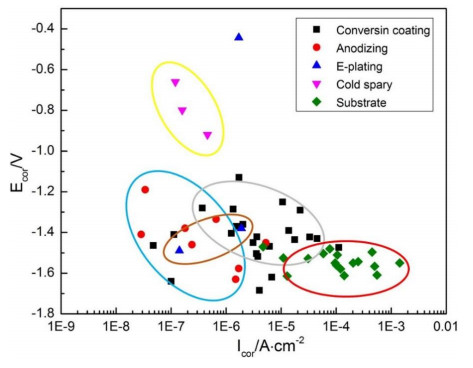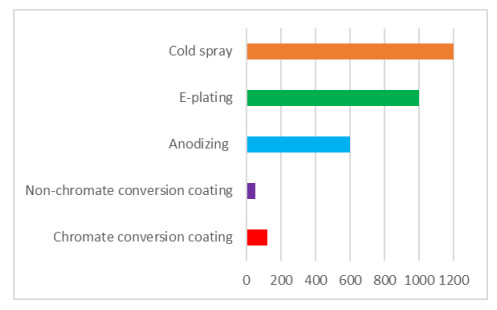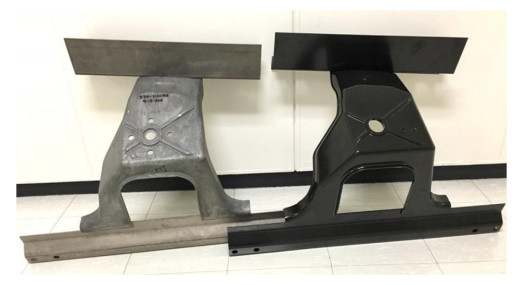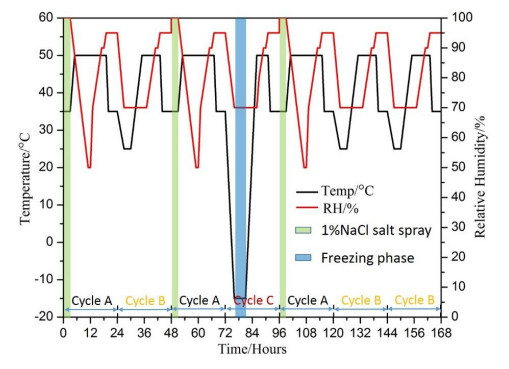Mg alloys find widespread applications in transportation industries especially in cars and trucks because of their edges in light-weight design, which can greatly help improve the fuel efficiency and decrease the gas emissions of vehicles; However, Mg alloys’ high sensitivity to the corrosive environments limit their penetration in automotive applications. Surface coating is one of the most effective and economic ways to protect Mg alloys from corrosion. Presently, the currently researched and commercial coatings that are specifically applied to Mg alloys in the automotive industry are reviewed in this paper. With some Mg automotive components subjected to corrosion and repeated load simultaneously, corrosion fatigue of coated Mg alloys are reviewed as well. Additionally, a part of attention in this review is given to the assessment approaches of corrosion and corrosion fatigue performance of coated Mg alloys for the purpose of material/surface coating system selection. Finally, some corrosion-related challenges for the growth of Mg alloys, future developments and research directions on surface coatings and corrosion fatigue testing approaches are discussed.
Abbreviations: CAFÉ: corporate average fuel economy standards; USAMP: United States Automotive Materials Partnership; MAO: Macro-arc oxidation; IMR: Institute of Metal Research; PEO: plasma electrolytic oxidation; LDHs: layered double hydroxides; SST: salt spray test; Ecoating: electrophoretic coating; PVD: physical vapor deposition; CVD: chemical vapor deposition; RH: relative humidity
1.
Introduction
As the lightest structural metallic materials, Mg alloys have found numerous different applications in various fields, including ground/air/marine transportation industry, electronic components, biodegradable medical implants, and hydrogen storage and battery electrodes etc. [1,2,3,4]. In particular, the usage of Mg alloys in automotive industry accounts for 90% of all the Mg alloy consumption [5]. These is increasing interest in constructing lightweight vehicles with improved fuel efficiency and reduced greenhouse gas (GHG) emissions, to meet the demand of corporate average fuel economy standards (CAFÉ ). According to the United States Automotive Materials Partnership (USAMP), it is estimated that by 2020,500 lbs of steel and 130 lbs of aluminum per vehicle will be replaced by 350 lbs of magnesium alloys. That is an overall weight reduction of 15%, which will lead to 9–12% fuel savings and a significant drop in GHG emissions [6]. Moreover, improvement of the vehicle's handling and turning capabilities and the reduction in vibration and overall noise could also be achieved through use of magnesium alloys. Currently, most of Mg alloys are used as die castings because of their excellent castability. For example, the transfer case representing a high volume of Mg application in vehicles is generally made of Mg AZ91 (Figure 1a). AE42, AS41/21 alloys with good strength and creep resistance at high temperatures are also commonly used in transmission case. AM50/60 that offer good ductility and excellent energy-adsorption ability are widely used in the interior components such as instrument panel (Figure 1b) and lift gate inner (Figure 1d) and in some chassis parts such as cross-car beam (Figure 1c). A summary of the current Mg alloy applications in the specific areas of a car are presented in Table 1.
However, the penetration of Mg alloys in automotive applications was not a complete success. Even though around 350 lbs of different Mg parts have been approved acceptable for use in chassis, interior, body and powertrain systems through laboratory tests according to the USCAR 2006 standards, there is still only 11–14 lbs of Mg components used in an average North American vehicle [19]. One of the main reasons for the low penetration is that Mg alloys are highly susceptible to corrosion environments, and unlike Al alloys, the protectiveness of the surface films formed on the alloys is very limited [20,21,22,23,24]. Considering the fact that applications of Mg alloys in automotive components such as door frames, front end structures, hatch backs and wheels are unavoidably subjected to corrosion attack in practical service conditions, a lot of research attention has been directed towards improving the corrosion resistance of Mg alloys via approaches including alloy development, proper structural design, and surface coating [25]. Among the various corrosion mitigation strategies, surface coating is considered as one of the most effective and economic ways to prevent corrosion of Mg alloys. It provides a physical barrier between the corrosive environments and the Mg alloy substrate, and can considerably increase the polarization resistance of the alloy substrate and hence retard its corrosion significantly [20]. Nowadays, numerous coatings have been developed and are applicable to Mg alloys, each with their own advantages and disadvantages. Examples of these coatings include chemical conversion coating, anodizing, electroless/electro-plating, organic coating, laser surface treatment, vapor (physical vapor and chemical vapor) based deposition and thermal/cold spray, on which informative reviews can be found in Refs.
[19,26,27,28,29].
The purpose of this paper is to provide an overview on the currently used and researched coatings on Mg alloys in automotive applications. The state-of-art research on corrosion fatigue of coated Mg alloys is reviewed with research interest deviating to wrought Mg alloys. Special attention is dedicated to the evaluation methods of corrosion and corrosion fatigue performance of coated Mg alloys. In addition, this paper covers the current challenges associated with corrosion for the growth of Mg in automotive industry and gives the future trends on the development of corrosion protection research and corrosion/corrosion fatigue testing methods on Mg alloys as well.
2.
Corrosion protection strategies for Mg alloys
A coating system is typically needed to achieve a class A (Class A in automotive industry refers to the glossy, smooth appearance that is required for readily visible, outer surfaces of automobiles) quality of surface finish on Mg parts, as shown in Figure 2 [30]. In the coating system, the first step is the surface treatment (i.e., the chemical conversion coating or anodizing, etc.), aiming at removing the mill and pressing oils and improve corrosion resistance and paint adhesion property. Then a precursor such as E-coat is applied to further enhance corrosion resistance and to improve the ability against mechanical damage, followed by the final topcoat consisting of a base coat and a clear coat to ensure the stability of the coating system and to provide an appalling effect as well.
In most cases, prior to the application of the surface treatment, Mg components must go through a cleaning process and an activation process, as shown in Figure 3. The method of cleaning includes mechanical (e.g., grinding, polishing) and chemical (e.g., alkaline degreasing, organic solvent cleaning) cleaning approaches, which together macroscopically and microscopically remove most of the oils, lubricants, dirt, oxide or hydroxide layers arising from previous manufacturing or forming processes respectively. Then, the activation process (usually an acidic pickling for Mg alloys) is used to further provide a homogenous and oxide free Mg surface for the subsequent surface treatment. Detailed information regarding the surface preparation of Mg alloy prior to coating has been described by Höche D, etc. [31] and standard procedures can be found from Standard ATSM D 2651.
As for the surface coating, various methods have been developed for Mg alloys. Based on the data from web of science using corresponding key words such as "conversion coating AND magnesium", the number of publications for different surface coatings since 1990 have been illustrated in Figure 4.
It appears that anodizing & MAO, chemical conversion coating, and chemical vapor deposition attract considerable researcher attention. Further, ion implantation, organic coating, and plating (include electroless plating and electrochemical plating) account for a large portion of those publications as well. In addition, according to a review on corrosion protection of Mg alloys based on patents [32], chemical conversion coating, anodizing, plating, and organic coating were represented as the most widely used methods to improve the corrosion resistance of Mg alloys. Therefore, the emphasis of the next section will is placed on these four types of coatings and their applications in automotive. Other processes like the vapor based deposition, and some emerging techniques such as cold spray will also be briefly introduced.
2.1. Chemical conversion coating
Chemical conversion coating is one of the most widely adopted surface treatments technologies in industries due to its excellent binding strength, low cost, good corrosion resistance and simple operation procedures [28]. By simply immersing the substrate into a conversion bath for a certain time duration, an adherent, insoluble, and crystalline or amorphous layer can be produced to provide corrosion resistance and good paint adhesion to Mg alloys. The formation process of a chemical conversion coating normally occur as follows: (a) Dissolution of Mg alloy at the anodic Mg-matrix and evolution of hydrogen preferentially around the cathodic intermetallic phases take place upon the substrate exposed to the conversion solution; (b) a localized increase of pH due to the consumption of H+ at the intermetallic compounds promotes the reaction of metal ions Mx+ with OH−, leading to nuclei of highly insoluble hydroxides M(OH)x and sometimes oxides MxOy as coating composition; (c) with immersion time increasing, the coating gradually grows from those nuclei until cover the entire substrate surface; longer time durations will increase the thickness of the coating [33,34,35]. The most common conversion coating used on Mg alloys in automotive industry had been a chromate treatment (e.g., dichromate, chrome manganese, and chrome pickle) [27]. Cr-based conversion coatings could provide high levels of corrosion protection, abrasive resistance, good paint adhesion and self-healing capability, but nowadays their use is strongly limited because of the main drawback represented by the toxicity issue. Therefore, a number of non-chromate chemical conversion coatings have been developed to substitute the Cr-based conversion coating: for instance, phosphate based coating [36,37,38,39], stannate coating [40], fluorozincate/fluorotitanate coating [41,42], Ti/Zr coating [43] and rare earth coating [44,45]. A comparison of different types of chemical conversion coatings is summarized in Table 2.
At present, one of the most widely used pretreatments in automotive industries is Zn phosphating, as reviewed in Ref. [46]. Since this phosphate solution is acidic (pH = 3.0–3.5), Mg parts will be highly dissolved when entering the bath. Moreover, in contrast to an alkaline cleaning process for steel and Al components, Mg alloys require an acidic cleaning. Thus, the current way to address this issue is separately treating single Mg pieces before they are assembled to the vehicle. From Table 2, phosphate based coatings (mainly Mn-P), conversion coatings based on Ti-, Zr or Ti/Zr seem to be the most promising options for Mg parts in automotive industry, which can be demonstrated from the current commercial products as presented in Table 3. Among them, phosphate based coating is commonly used and not toxic, but there are some other environmental issues. For example, the phosphate baths can generate massive sludge containing metal ions and can cause some environmental problems such as eutrophication in lakes. The conversion coatings based on Ti-, Zr or Ti/Zr are relatively new and are developed to replace phosphate based coatings. The problems caused by phosphate baths are solved now by conversion coatings based on Ti-, Zr or Ti/Zr due to the use of free of phosphate compound baths with a tiny amount of ionic species [47,48]. At this time, these conversion coating are already commercialized in the surface treatment of Al alloys and some steels, but there is only a few data with respect to Mg alloys [48,49].
As for the commercial conversion coatings applied to corrosion protection of Mg automotive components, it has been reported that a conversion coating with brand name Henkel Alodine 5200 was used to protect the Mg instrument panel from pitting on the sport car 2005 Ford GT [50]. The corrosion protection of Mg lifegate on the 2010 Lincoln MKT also included the Alodine 5200 sub-micron thick chemical conversion coating [19]. Alodine 5200 developed by Henkel is a Cr-free Ti-based conversion coating and specifically formulated for treating non-ferrous alloys, and in particular, an Alodine M206 formulation is specifically developed for AZ class of Mg alloys. A Cr-free conversion coating based on Ti/Zr has been used on the Mg doors of the Ford Contour vehicle [19]. The combination of MagPass-Coat and a 200 μm polyester powder coating was used to protect the inlet pipe of the Audi W 12 Mg (AZ91) cylinder engine [14]. MagPass-Coat is a chrome-free conversion coating suitable for all Mg-based material, but typical thickness of the coating is less than 1 μm. Also, Meridian Technologies applied a conversion coating base on fluorozincates and fluorotitanates to a front end carrier [19]. In a Canada-China-USA collaborative R & D project aiming at developing comprehensive application technology suitable for Mg alloy in the front end where corrosion is a major concern, researchers from Institute of Metal Research (IMR) developed an environmentally friendly and corrosion resistant conversion coating from a Mn-based phosphate bath [51]. Similar coating properties are expected due to the similarity of permanganate to chromate as a strong oxidizing agent in conversion process. This coating has now attained industrialization level and already been used in the Mg alloy hood shield by FAW, as shown in Figure 5.
Chemical conversion coating mainly functions to improve corrosion protection and paint adhesion to the subsequent organic coating or top coating process, and also can protect the Mg components during transport and storage. However, the corrosion protection provided by this type of coating is very limited because chemical conversion coating is generally too thin and too weak, making it easily damaged during assembly. For example, the thickness of Magpass-Coat is typically less than 1 μm [55]. Besides, the quality of the surface treatment is very sensitive to the previous cleaning process, activation process, and conversion bath parameters such as pH, immersion time or temperature. It is difficult to produce a conversion coating which is defect-free and uniform. Therefore, there remains a strong demand for developing more robust, chromate-free conversion coatings, especially involving self-healing capability.
2.2. Anodizing
Anodizing is a widely used strategy to produce a thick, hard, stable and ceramic-like coating which can offer excellent corrosion protection of Mg parts [27]. In addition, the anodized layer can provide excellent wear resistance, which therefore makes Mg components less likely to be damaged during assembly than conversion coating. The anodizing coating usually has a porous morphology and a cellular structure as shown in Figure 6. The porous nature of anodizing makes it an excellent paint base in the vehicle coating line and cosmetic finish can be obtained. However, porous structure is not beneficial to the corrosion resistance of anodized coatings. For example, Cui et al. [62] correlated the porosity of the MAO coating with its corrosion resistance. It was concluded that the through-pores and micro-cracks existing in the MAO coating played a more dominant role in deciding the protective efficacy of the coating than non-through pores and the MAO coating thickness as through-pores and micro-cracks can provide direct pathways for corrosive species to reach the Mg substrate. The porosity size and distribution can also influence the corrosion resistance. Thus, it is very necessary to seal the anodized film to achieve enough corrosion resistance. The presence of intermetallic compounds is as well reported to have a significant influence on the corrosion resistance of MAO coating [63]. On one hand, the different coating growth rates between intermetallic compounds and Mg-matrix may cause discontinuity of MAO coating; thus, homogenous distributed phase tend to obtain a MAO coating with enhanced corrosion resistance. On the other hand, degradation of MAO coating preferentially starts from the vicinity of intermetallic compounds, as demonstrated in several literature [64,65]. Therefore, it is important to control the size and distribution of intermetallic compounds and reduce the through-pores and micro-cracks to gain a high quality of MAO coating [66,67].
Essentially, anodizing is an oxidation reaction in the aqueous solution which can be technically accomplished by two different conditions: voltage controlled or current controlled. Different voltage or current regions result in different coating formation processes such as sparking, micro-arcing anodizing at high voltages. Conventional commercial anodizing treatments using relatively low voltage such as DOW 17 and HAE [26] can provide superior anticorrosion property on Mg alloys, but their anodizing baths include chromates and/or HF and thus they are restricted to be used in industries now. New anodizing processes called micro-arc oxidation (MAO) or plasma electrolytic oxidation (PEO) [69], which are much less hazardous, have been developed. MAO employs higher voltage than conventional anodizing such that micro discharges occur and the resulting plasma modifies the surface structure of Mg alloys. This MAO process can produce thicker layer with higher corrosion and abrasion resistance as well as improved temperature and load capacity compared with the DOW 17 and HAE heat process.
At present, anodizing has been successfully used in the Al alloys for many years. However, it is more complicated when this technique is applied to magnesium alloys. For example, it requires much higher voltage to anodize Mg alloys than Al alloys. The microstructure of the anodizing coating formed on Mg alloys is irregularly porous while it is regular for Al alloys. Some industrial anodizing processes developed for Mg alloys are summarized in Table 4.
These commercial anodizing films have already been applied in Mg automotive components such as gearbox housing, wheel rim, engine blocks, door inners, suspension parts, intake manifolds, cradles, pistons, etc. An example of Tagnite coating in protection of Mg oil pump housing is shown in Figure 7 [71]. Also, in a case of a hybrid-electric Ford Focus, an Al part used to house the power distribution unit was replaced by an Mg one, in which the Mg surface was protected with a Tagnite anodizing coat [19]. The Tagnite and Keronite processes can produce highly hard anodized coatings on Al and Mg alloys which provide another level of corrosion resistance and paint adhesion beyond other types of anodized coating. The much higher electricity usage and electrolyte consumption than other anodizing line limit their use in automotive industry. Therefore, they are typically used in aerospace and military applications.
There is no question that the anodizing coating can offer a better corrosion resistance, wear resistance and paint adhesion property than conversion coatings. However, they have also suffered some challenges. For example, the electrochemical inhomogeneity due to the phase separation in magnesium alloys makes it difficult to produce an adherent and uniform coating. Besides, the fatigue strength of magnesium alloys modified by this surface treatment is evidently decreased. Furthermore, anodizing has environmental issues and is more expensive due to the consumption of electricity.
2.3. Electrochemical plating
Apart from chemical conversion coating and anodizing, electrochemical plating has achieved commercial importance on Mg alloys, not only because of the improved corrosion and wear resistance but also as the deposited metallic coatings on Mg parts surface offer beautiful appearance, good solderability, electrical and thermal conductivity. Electrochemical plating is actually a reduction process, in which the dissolved metal ions in the bath are reduced to their metallic form and deposited on the surface of the part. Unfortunately, high chemical activity makes Mg alloys very difficult to be plated. Only Ni and Zn can be directly electroplated on Mg alloys. A suitable pretreatment as an undercoating to prevent Mg surface from oxidation but can be removed when plated is needed to further the subsequent plating. At present, zinc immersion and direct electroless nickel plating are widely used pretreatments in Mg alloys [26,72,73].
Electrochemical plating is generally classified as electroplating process [73] and electroless plating process [74] by different driving forces for the reduction process. An external force such as voltage is necessary for an electroplating process and a chemical reducing agent for an electroless plating process. As with the electroplating, different metallic coatings such as Ni, Zn, Cr, Cu, Ag, and Au have been applied to Mg alloys according to specific applications. For example, Cu is always used as a base layer to ensue good adhesion in multiple-plate electroplating; Ni is used to improve the corrosion resistance; Ag is used for anti-fretting purposes; Both Ag and Au are sometimes used to provide electrical conductivity and optical reflectance. Instead of a single metallic layer, multilayered metal coatings are commonly used on Mg components. Cu/Ni/Cr coatings are conventionally applied to some indoor and mild outdoor Mg components in automotive applications. For example, a Cu/Ni/Cr coating with Zn immersion pretreatment was reported to be used in the Mg interior panel of Porsche Cayenne [73]. Some other examples of plated Mg component in automotive industry have also been presented in Ref [75] (Figure 5 to 7). Another multilayered Ni/Au coating for Mg alloys is mainly utilized in the aerospace field. As for the electroless plating, Ni-P is the most common process. By immersing the parts into an aqueous solution, a uniform thickness film can be produced on even an irregular surface. Generally, due to limited corrosion protection, electroless Ni-P plating after sealing tends to be applied in mild industries such as computer and electronic (3C) industries [26].
Nevertheless, electrochemical plating still has some challenges in the application of Mg alloys. Not to mention magnesium's high susceptibility, the intermetallic phase such as MgxAly distributed along grain boundaries makes it especially difficult to uniformly plate magnesium alloys. Moreover, different Mg alloys requiring different pretreatments makes the plating process more complicated. Additionally, as the noble metallic coatings have a big electrochemical potential with respect to Mg alloy, galvanic corrosion would easily occur if the plating has pores and is not uniform. Other problems such as the large consumption of electricity and difficulty in coating complex shapes in electroplating, short bath life in electroless plating, also limit their applications.
2.4. Organic coating
Organic coating, which plays a significant role in improving corrosion resistance, wear property and decoration, is commonly used as a topcoat in a normal coating system for Mg alloys [26]. Resin (e.g., epoxy, vinyl, acrylic polyurethane) is the main composition of an organic coating. Typically, organic coating is composed of a binder, pigments and additives such as dryers, stabilizing agents, corrosion inhibitors, etc. Prior to organic coatings, an appropriate surface preparation is critical because of their poor adhesion strength. Not only does it require the surfaces of Mg alloys to be free of contaminants, smuts and oxides, but the water and air in the defects must be removed as well. According to Hu's review [60] on the progress of organic coating for Mg alloys, it can be known that organic coatings can be formed by several techniques such as painting, powder coating, electrophoretic coating (E-coating), sol-gel coating and plasma polymerization. Table 5 simply summarizes a description of these techniques and corresponding advantages and disadvantages.
Currently, powder coating and E-coating are the two most popular organic coatings used in the corrosion protection of Mg components in automotive industry [77]. It has been reported that powder coating was the best top coating for corrosion protection of Mg alloys because powder coating could provide better general and galvanic corrosion resistance than E-coating [77]. Yet, some other researchers argued that E-coating of Mg had more advantages than powder coating, such as lower cost, no line-of-sight limitations, and the capability of coating complex parts [7]. Some commercially available products for powder coating (e.g., from ProTech, Akzo/Interpon and DuPont) and for E-coating (e.g., from PPG, BASF, and DuPont) have both been reported to be used in protection of Mg automotive parts [78]. For instance, in a case mentioned above, the Mg instrumental panel of the sport car 2005 Ford GT was first pretreated by Henkel Alodine 5200 conversion coating, then followed by a Protech epoxy urethane powder coating [19]. Figure 8 also shows an application example of powder coating in certain Mg engine parts [79].
Similar to other coatings, some challenges also appeared in the deposition of organic coating on Mg alloys. First, a uniform, defect-free organic coating is difficult to be produced on Mg surface without careful surface preparations. Even so, an additional layer of polymer or other powder coating on top of that is still necessary. Thus it is necessary to apply multiple layers of these coatings to achieve sufficient corrosion performance. Besides, there are still some environmental issues because of the used solvent in these coating processes.
2.5. Other process
Other surface technologies such as layered double hydroxides (LDHs), cold spray, thermal spray, physical vapor deposition (PVD), chemical vapor deposition (CVD), and laser surface coating have been also applied to improve the corrosion resistance of Mg alloys [26,27,80], but few of them achieved commercial applications in automotive industry. LDHs with a tunable brucite structure are essentially a class of anionic clays (e.g, NO3−, PO43−, CO32−) [81,82,83,84,85]. Their unique layered structures regarded as nanocanpsules are capable of storing and releasing corrosion inhibitors, which allow researchers to develop more functional coatings. Besides, LDHs can be used to replace the conventional sealing strategies to seal the anodized film. However, so far this surface technology are mainly developed for medical application, more research is needed to extend their application. Cold spray is an emerging technique to coat and repair a wide range of industrial components [86,87]. It was initially aimed at being applied to the aerospace industry because it can provide much harder, thicker coatings compared to other available coatings. However, with this technology moving forward, there is a high potential of its commercialization in automotive industry. Different from the conventional thermal spray processes such as flame spraying, arc spraying and plasma spraying which requires heating sprayed particles into molten metal droplets, cold spray is a process of applying coatings by exposing the substrate to a high velocity (300–1200 m/s) powder particles accelerated by a supersonic jet of compressed gas such nitrogen, helium, air or a mixture of them at a temperature well below the melting temperature of the material, i.e., forming coatings from particles in the solid state. In this way, it mitigates or even eliminates the deleterious effects of high temperature oxidation, phase transformation, residual stresses, porosity and other problems resulting from the thermal spray approaches. The plastic behavior of both particle materials and the substrate is closely related to the formation of the cold sprayed coating. When high velocity particles impact with the substrate, severe plastic deformation of the particles occurs. At the same time, significant penning effect due to the impact of particles on substrate surface induces deformation of the substrate. Consequently, the interfacial deformation and localized heat between sprayed particles and the substrate contributes to forming a coating with good adhesion property by mechanical interlocking and metallurgical bonding. It is recommended that the material with more plastic than the substrate should be utilized.
To date, pure Al, aluminum alloys, aluminum alloys blended with Al2O3 have been used to coat various Mg alloys by the cold spray technique [88,89,90,91]. Result shows that cold sprayed coatings can significantly improve the corrosion resistance of Mg alloys, which show their promising application in corrosion protection of magnesium alloys. However, as an emerging technique, cold spray is still mainly in research and development stage, more coating performance data needs to be collected.
2.6. A comparison of corrosion performance of different coatings
As one of the main functions of surface coatings is to improve Mg alloys' corrosion resistance, it is necessary to notify the effectiveness of different coatings. A lot of factors can influence the corrosion performance of a coating, but the decisive points lie in the substrate, the coating, the measurement solution, and the measurement method. Therefore, for a reliable comparison, all the data collected here are from electrochemical measurements with same reference electrode in 3.5% NaCl solution and standard B117 salt spray test on AZ31 and AZ91D alloys [65,92,93,94,95,96,97,98,99,100,101,102,103,104,105,106,107,108,109,110,111,112,113,114,115,116,117,118,119,120,121,122,123,124,125,126,127,128,129,130]. Corrosion current density and corrosion potential of each coating as well as the AZ31 and AZ91D substrate were plotted in one graph, as shown in Figure 9. Lower corrosion current density and higher corrosion potential represent better corrosion resistance. It can clearly be seen that cold spray coatings show the best corrosion resistance with corrosion current density exceeding 1.0 × 10−7 and corrosion potential exceeding −1.0 V, followed by anodizing and then E-plating. Chemical conversion coating only shows moderate corrosion protection in comparison with other types of coatings. The scatter of these data in one type of the coating was explained by the different use of bath compositions, but the large scatter of corrosion current density in the substrates remains further research.
Figure 10 shows similar salt spray test results of AZ31 and AZ91 alloy with different coating. The conventional chromate conversion coating can generally withstand up to 120 hours in the 5.0% NaCl spray solution, whereas non-chromate conversion coatings last only 24–48 hours in the test. In contrast, anodized coatings remain complete for hundreds of hours and E-plating and cold spray coatings can even achieve up to 1000 hours of ASTM B-117 salt fog test. Nevertheless, once the top coating is applied, all these coating systems can exhibit superior corrosion resistance.
3.
Challenge and outlook
The wide implementation of Mg alloys in the automotive industry need to overcome the corrosion problem. For automotive interior components, Mg alloys show relatively good corrosion resistance. However, with the applications of Mg alloy spreading to external parts that are probably exposed to corrosive environments (e.g., water, mud, debris, SO2, salts species), corrosion protection is a big issue. General corrosion of Mg alloys has been greatly mitigated by the developed surface coatings, but there are still some corrosion-related challenges for the growth of Mg alloys.
3.1. Galvanic corrosion of coated Mg alloys
In fact, galvanic corrosion has become the major challenge that restricted the penetration of Mg alloys in automotive industry. Joost et al. [18] stated that a Mg engine cradle previously used on the Chevrolet Corvette Z06 from year 2006 to year 2013 was replaced by an Al one on the 2014 Corvette Stingray. Because high cost resulted from the galvanic corrosion mitigation of the Mg engine cradle which has to be attached to other body structure offsets the lightweight savings benefit. A recent project named by "Magnesium Front End Research and Development" highlighted the galvanic corrosion protection challenge for the assembled structure [7,131]. The picture on the right in Figure 11 shows a multi-material structure with a steel upper rail and an Al lower rail attached to an Mg shock tower. All component parts were pretreated using Henkel Alodine 5200 prior to being riveted and then the assembled part was treated by PPG 590-534 cathodic epoxy E-coat [131]. Without exception, corrosion bloom was observed at all self-piercing rivets. In many cases, Mg alloys need to be joined with steel and/or Al alloy during their use in automotive applications. Since Mg is anodic to all other engineering metals, galvanic corrosion would readily take place when Mg is directly assembled to dissimilar metals. To the author's knowledge, proper structural design, satisfactory spacer materials, surface coating, and appropriate metal combination are able to significantly improve the galvanic corrosion resistance of Mg alloys [77]. Surface coating seems not to be the best way to protect Mg alloys against galvanic corrosion, but in some cases coating of Mg alloy cannot be avoided, so a careful coating system selection is very important.
Another challenge lies in the incompatible surface treatment of Mg alloys with other metals such as steel, Zn, and Al in the automotive finishing lines [25,77]. Generally, steel and Al parts must go through a standard phosphate process before subsequent surface modifications. Unfortunately, this phosphate solution, which is acidic, could not offer enough paint adhesion to Mg alloys and Mg alloys can even pollute the phosphate bath because of its dissolution. Therefore, Mg parts should be properly coated before they are assembled to the car, which in turn may damage the coating on Mg surface during the process of assembly.
For the future, despite much effort in the development of surface coatings for Mg alloys, there is still a need for more robust coatings. Advanced functional and smart coating with incorporated corrosion inhibitors, inorganic nanoparticles, anti-fouling agents, etc. are viewed as a highly active topic for the future work [132,133]. In addition, development of universal pretreatments and coating processing for multi-materials will as well become an important domain [20].
3.2. Corrosion fatigue of coated Mg alloys
Mg parts are mostly provided in cast alloys because of their superior castability. Recently with research interest deviating to wrought Mg alloys, which exhibit better mechanical properties comparing with cast alloys, the application of Mg alloys gradually spreads to some load-bearing situations. Thus, some Mg parts are inevitably subjected to a cyclic load and simultaneously a corrosive environment, which can be called corrosion fatigue. The synergistic effects of the corrosive environment and cyclic loading can lead to much earlier failure of structures and components than that by stand-alone corrosion or fatigue. Much literatures [134,135,136,137] have revealed that fatigue strength and fatigue life of Mg alloys would be significantly decreased in the presence of corrosive environments. Similar to corrosion issues, since surface coatings could isolate Mg parts from corrosion species, they are assumed to have the ability to improve the corrosion fatigue resistance. Table 6 summarizes the current found literature on the corrosion fatigue behavior of Mg alloys with different surface coatings, including epoxy coating, chemical conversion coating, electroless plating, electroplating, conventional anodizing, MAO or PEO coating, painting, diamond-like carbon coating, and cold spray coating. The effectiveness of these surface coatings on fatigue properties can be roughly ranked as follows: cold spray coating/painting > chemical conversion coating/painting > painting > chemical conversion coating, PEO coating/painting > electroplating > electroless plating, conventional anodizing/painting > conventional anodizing. From the literature review, we can find that only epoxy coating [138,139,140], diamond-like carbon coating [141] and Al 7075 cold spray coating/painting [142,143] have been reported to improve the corrosion fatigue strength to the level of the corresponding uncoated specimens in air or even higher. However, the frequency used in studying the effect of that epoxy coating on fatigue behavior [138,139,140] is too high to let the corrosion species affect the fatigue process, so the author believed that this epoxy coating probably did not have the ability to improve the corrosion fatigue strength at other frequency or other experimental conditions. Some other experimental results using similar organic coatings [144,145,146,147] also supported this idea. On the other hand, the corrosion fatigue tests of the Mg alloy with diamond-like carbon coating were only conducted in a distilled water, rather than in some salt solutions where this diamond-like coating may exhibit decreased corrosion fatigue strength. Therefore, to the author's knowledge, Al 7075 cold spray coating/painting is the only reported surface coating that can enhance the fatigue property in severe environments to the same level as that of uncoated specimens in air. However, as discussed above, cold spray is still in the stage of research and development and thus is commercially limited. Therefore, corrosion fatigue is as well a challenge for the growth of Mg alloys in automotive industry.
It could be found from literature that fatigue crack usually initiates from the weak sites of matrix/coating interfaces, the defects existing in the coating layer, strain capacity mismatching of the coating and the matrix, or from the large surface roughness of the coating [160]. Therefore, to enhance the fatigue properties in corrosive environments, the future works should concentrate on developing a homogenous, defect-free, corrosion resistant coating with a strong bonding adhesion to the matrix.
3.3. Corrosion and corrosion fatigue evaluation methods of uncoated and coated Mg alloys
Another challenge lies in the evaluation of corrosion and corrosion fatigue performance of Mg alloys with or without surface coatings for the purpose of material/surface coating system selection. As to the characterization of corrosion performance, the most reliable approach is to conduct a field corrosion exposure test, which, however, is costly and much slow (generally takes 2–8 years) [161]. Thus, to meet the industries' need for fast and dependable corrosion ranking of materials, a large number of accelerated corrosion techniques have been developed [20]. The commonly used accelerated corrosion tests to simulate the real-world exposures in industrial research include some static corrosion tests such as neutral salt spray (ASTM B117 [162]), immersion test (ASTM D870 [163]), humidity test (ASTM D2247 [164]) and some cyclic corrosion tests. It has been generally accepted that these static corrosion tests do not give a well correlation with the realistic results. For example, Standard ASTM B117 always provides much higher corrosion rates of Mg alloys as compared to that obtained by field exposures [165]. Nevertheless, it is still a widely used method to rapidly give a comparative corrosion assessment of numerous materials and coatings. On the other hand, humidity tests and other immersion tests are indeed more of intended to investigate and identify the effect of critical factors in the field environments on the corrosion performance. Today, there has long been agreed that a cyclic corrosion test that typically involves alternating exposure to salt spray, dry and wet conditions is the best way to accurately predict the corrosion performance of various materials and coatings. A large number of cyclic corrosion tests, which vary from each other in parameters such as salt solution concentration, relative humidity (RH), exposure time to salt solution, etc., have been developed by many auto companies. Table 7 outlines the commonly employed cyclic corrosion tests by various auto makers and Figure 12 shows the VDA 233-102 [166] corrosion testing procedures which has a freezing phase to simulate the corrosion behavior of automotive materials during cold winter in countries such as Canada.
It is worthy to notify that most of these cyclic corrosion tests were originally developed for automotive steels and Al alloys. For example, the development of Standard SAE J2334 was based a 5-year vehicular exposure performance of cold rolled and painted steel in Montreal and St. John's [167]. Standard ASTM G85-A2 is used to test the relative resistance of Al alloys to corrosion, which was supported by the USAMP work that Standard ASTM G85-A2 and -A4 could obtain the best correlation to vehicle exposures for 6000- and 2000-series Al alloys [168]. In the case of Mg alloys, however, some of these cyclic corrosion tests may lead to poor results in the corrosion ranking or durability prediction. An assessment of 9 OEM corrosion test protocols combined with an underbody vehicular exposure in Southern Ontario in Canada for as-cast and powder coated AM60B Mg substrates was conducted [169]. General corrosion, galvanic corrosion and corrosion creep at a scribed line on coated plates were characterized according to Standard ASTM D610, Standard ASTM G46, and Standard ASTM D1654, respectively. Results showed that as compared to the field exposure data, cyclic corrosion tests with great cumulative exposure to salt solution significantly exaggerated the cosmetic corrosion of as-cast and powder coated Mg alloys and galvanic corrosion with Al isolation to the Mg substrates. Only three cyclic corrosion tests with little cumulative exposure to salt solution including SAE J2334, L-467 and TPJLR 52.253 could give relatively good correlations. This indicates that the vehicular exposure seemingly tends to be simulated by those mild laboratory cyclic corrosion tests. However, for the galvanic corrosion without isolation to the substrate, those moderate cyclic corrosion tests such as BMW AA-0224 tend to provide more realistic results. Further, results showed that there was no big difference in the corrosion creep performance of powder coated Mg alloys for all the accelerated corrosion tests. Apparently, cosmetic corrosion and galvanic corrosion performance of Mg alloys cannot be characterized by one same corrosion protocol. There is a need for developing more improved cyclic corrosion tests to address different corrosion behavior or simulate different exposure environments even though there are several corrosion protocols capable of providing relatively good correlations to field exposure.
As to the characterization of corrosion fatigue performance, the most reliable way is to perform fatigue tests under real stress cycle in the service environment, which, however, is extremely time-consuming. As reported, the alternative way that takes much less time is to accelerate the corrosion process at the same rate as accelerating the fatigue frequency [174]. Currently, there are two approaches to evaluate corrosion fatigue properties of metals: one is conducting the fatigue test with simultaneous accelerating corrosion and the other one is pre-corroding the specimen before the fatigue test. For the former one, nowadays it is feasible to control the corrosion rate, but the interaction between fatigue and corrosion may make the controlling of corrosion rate challengeable. Nevertheless, rotating bending test under simultaneous corrosion is still widely used to characterize the corrosion fatigue endurance, as indicated in Table 6. For the latter one, as the corrosion process occurs before fatigue test, the ignored interaction between fatigue and corrosion might lead to a very different result.
Considering the high sensitivity of Mg alloys to corrosive environments, a large number of variables coming from aspects of mechanic, geometry, metallurgy, and environment would influence the evaluation of corrosion fatigue properties. Thus, precise control of those variables in the corrosion fatigue tests is very important in the future. On the other hand, as the laboratory corrosion environments used in most of fatigue tests are continuous corrosion conditions rather than cyclic corrosion conditions which can mimic the real-life vehicle conditions [175], it is difficult to give a reliable estimation of corrosion fatigue life. Therefore, new device that could perform fatigue tests in cyclic corrosion conditions should be developed.
4.
Conclusions
Mg alloys have found a wide range of applications in automotive industry, but corrosion limits their extensive growth. Numerous surface technologies have been used to improve the corrosion resistance of Mg alloys in automotive applications, including chemical conversion coating, anodizing, electrochemical plating and organic coating. In this review, advantages and disadvantages of each approach are discussed. Besides, other corrosion-related challenges for the growth of Mg alloys in automotive industry are reviewed and should be considered in further study.
(1) Galvanic corrosion is the major challenge that restricted the penetration of Mg alloys in automotive industry. More robust coatings and coating processes suitable for treating multi-materials are in demand.
(2) Corrosion fatigue of Mg alloys requires more attention with research interest deviating to wrought Mg alloys. A homogenous, defect-free, corrosion resistant coating with a strong bonding adhesion to the matrix should be developed to enhance the corrosion fatigue strength of Mg alloys.
(3) More improved cyclic corrosion tests to address different corrosion behavior or simulate different exposure environments should be proposed. New devices that could precisely control the variables in corrosion fatigue tests and that could perform fatigue tests in cyclic corrosion conditions should be developed.
Acknowledgements
This work was supported by the Natural Sciences and Engineering Research Council of Canada, the Automotive Partnership Canada (APC) program (Grant No. APCPJ 459269-13). The author would like to acknowledge Dr. Xin Pang from CanmetMATERIALS and Dr. Hamid Jahed for their assistance in providing some literature and language refining.
Conflict of interest
All authors declare no conflicts of interest in this paper.










 DownLoad:
DownLoad:











